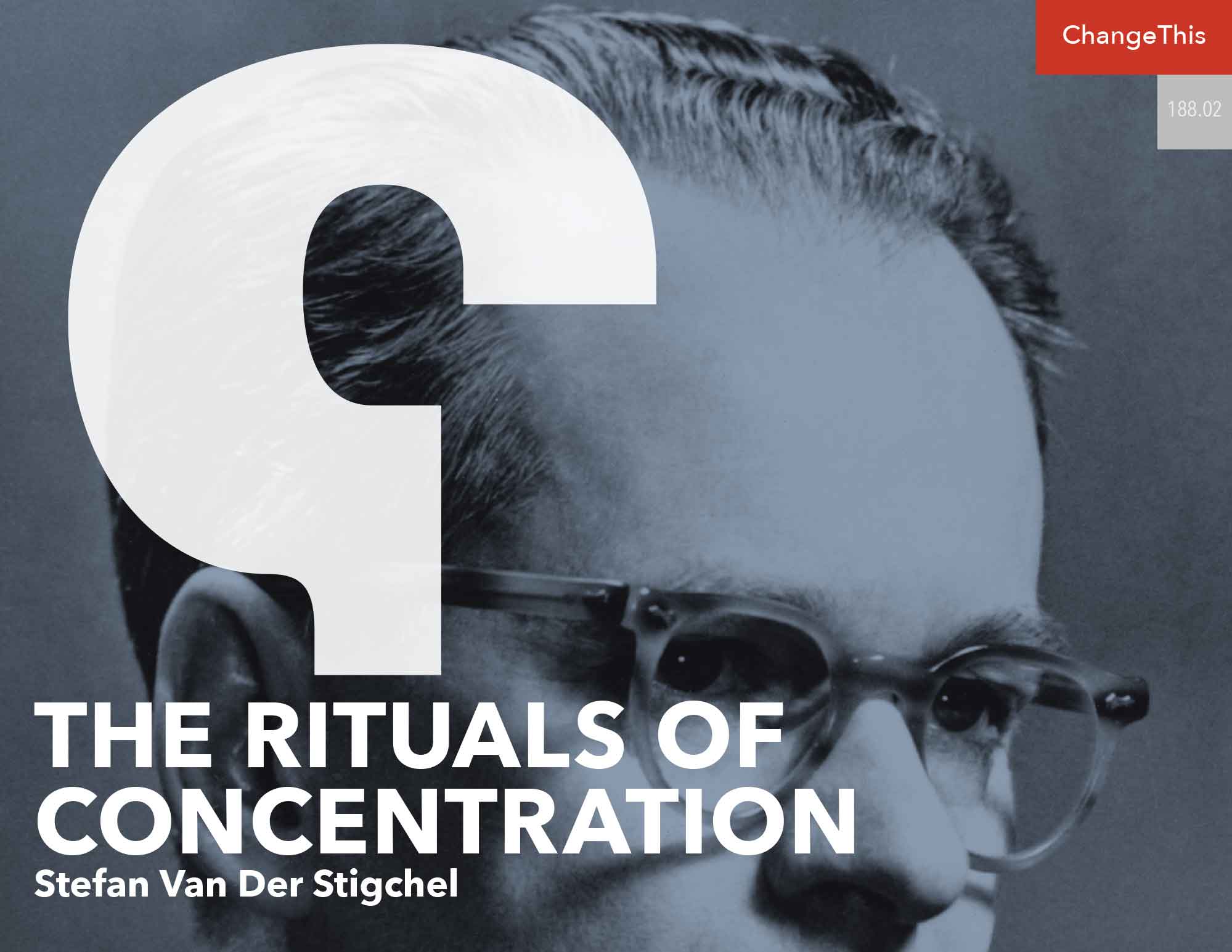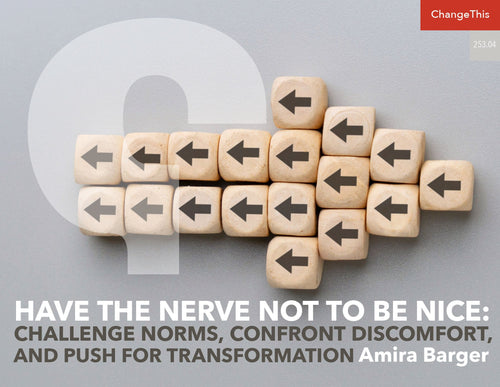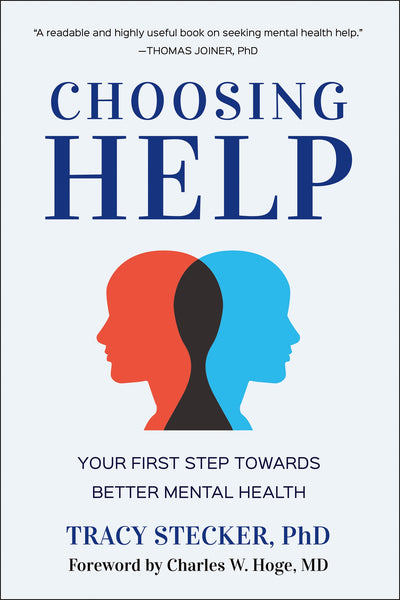The Rituals of Concentration
The American psychologist B. F. Skinner (1904–1990) was convinced that concentration can be conditioned, just like you can condition a dog to start slobbering at the sound of a bell.
Skinner is most famous for inventing the “Skinner Box,” an instrument used to study operant conditioning. An animal placed in a Skinner Box receives an automatic reward, usually in the form of food, when it executes a certain task correctly. This allows us to study how an animal reacts to a reward and how it learns to associate a certain activity with the potential of a reward.
As well as an inventor and psychologist, Skinner was also a very productive author, publishing twenty scientific books and countless articles during his lifetime. To be able to work hard, he used techniques from behaviorism, such as operant conditioning. Every morning he would begin his daily writing session by ringing a bell in order to create an association between the sound of the bell and his concentration. It was as if Skinner wanted to teach his brain to concentrate all by itself upon hearing the tinkle of a bell.
In actual fact, Skinner engaged in a whole series of rituals early in the morning before his writing session began. He rose at the same time every day and his breakfast always consisted of a bowl of cornflakes. Every morning he read the newspaper and a few pages of the dictionary. Then, at a fixed time, he would go to his study to start his day’s work. He always kept the same books close at hand and the same lamp on his desk. Switching the lamp on also set a clock in motion that tracked the time Skinner spent working. And, as if that wasn’t enough, he also kept a record of his own productivity. When the clock struck a certain hour, he counted the number of words he had written, just like the Skinner Box records the behavior of test animals.
It goes without saying that Skinner liked to measure things, and he is widely regarded as having contributed enormously to making the study of behavior more scientific. The bell was his constant companion, even towards the end his career when it would ring to summon him in the evening to his desk for another hour of writing, and it continued to ring long after he had officially retired. Skinner never stopped working, in fact, seven days a week all year round, and he never went on vacation. He died at the age of eighty-six in 1990 having published his last book only the year before.
Skinner adopted the same attitude towards his concentration as he did towards his experiments. It was almost as if he spent his entire life inside his very own Skinner Box. Always that bell, always that amazing productivity. A lot of people have their own rituals before engaging upon an extended period of concentration. The famous Dutch author Harry Mulisch began every morning the exact same way: a cup of coffee with a teaspoon of cream and a teaspoon of sugar, and a cracker with marmalade on the side. Mulisch was always immaculately dressed, even when he didn’t have to venture outside his front door. He stopped working to have lunch—always a boiled egg—at the exact same time every day, and finished his working day by taking a walk in the afternoon following the same route day in, day out. Mulisch was extremely organized in his work, which is not something we can say about everyone. The pianist Frédéric Chopin, for example, used to lock himself in his room for days on end, sobbing furiously while he broke one quill after another in frustration. All in the cause of analyzing and perfecting each note he wrote. It is said that it took him six weeks to complete a single page of music to his satisfaction.
These are but a few examples of the kinds of daily rituals that extraordinary people often follow in their lives. If you read the biographies of influential authors, painters, and composers, you will be sure to find many more. You could view it as a form of procrastination, of course, all that sharpening of pencils and ringing of bells before sitting down to work, but sometimes a ritual is exactly what you need to get yourself fully into concentration mode. But although there is no shortage of stories about moments of sheer genius striking people in the middle of the night, most brilliant books and paintings are the result of long, hard hours of work and lengthy periods of intense concentration.
Why are rituals so important to concentration? You could compare the rituals that precede a period of concentration to an athlete’s preparations before a major race. It is important to empty your mind and ignore all potential distractions. Your mental battery must be fully charged. Just like winning a race, a protracted period of concentration requires an enormous amount of effort, but then from the brain. To understand this better, we need to establish why concentration costs so much energy. Today we know a lot more about the processes in the brain that are related to concentration and, strangely enough, most of that knowledge comes from research into the processes that are active when we are not concentrating.
The majority of experiments using brain scanners, such as MRI and PET scanners, examine the activation patterns in the brain while performing a certain task. This enables identification of the brain cells that are used to carry out that task. One of the most important scientific breakthroughs of the past few decades was the discovery of the “default network,” a network of regions in the brain that are active during periods of rest. This is a brain state in which you are not actively performing any task; in other words, when your working memory is empty. We spend a large portion of our day doing things that do not make any demands on our attention. Taking a shower and cycling your usual route to work are examples of activities in which your default network is active.
It might be a good idea to pause for a moment and examine the term “network.” You have probably always been used to thinking of the brain as an organ made up of several different regions, all of which have their own individual functions; for example, executive functions are the domain of the frontal lobe, and basic visual perception is carried out in the occipital lobe. These days, however, neuroscience tends to think of the brain more in terms of networks than in regions. Some functions are not localized in one specific part of the brain but are executed on the basis of the activation of a network of different parts that are all interconnected. Think of the road network in the country where you live. Each individual city has its own special characteristics, but the ability of the country to function as a whole is largely dependent on the speed at which traffic can move from one city to another. The highways connecting the cities are like the pathways in the brain that enable communication between the different regions.
Nowadays, test subjects are often required to do nothing more strenuous than lie in a brain scanner, as it is through resting-state measurements that scientists are able to see which regions of the brain communicate with each other while at rest. When a test subject is not performing an activity, it does not mean that the brain is inactive. The brain can show spontaneous activation patterns among groups of neurons, and by correlating these patterns with each other it is possible to identify the different networks and see which brain regions are connected (and how strong those connections are). For example, we have long known that the regions that are responsible for controlling our movements are located in both halves of the brain, but we have since discovered that these regions are strongly connected to each other via pathways that traverse the two halves because we have seen that they exhibit the same type of spontaneous activity during periods of rest.
In 1929, Hans Berger, the inventor of the EEG, a monitoring method for recording electrical activity in the brain, revealed that his studies showed that the brain waves of test subjects did not stop when they were no longer performing any activities. His ideas were not taken seriously and for years after it was believed that the brain, or at least a part of it, was only active whenever a task was being carried out. It was only recently, as late as 2005, that Berger was proven to have been right all along. In that year, Marcus Raichle of the Washington University School of Medicine in St. Louis discovered that the brain only uses 5 percent more energy when performing an activity compared to the situation when it is performing none.
His discovery of the default network was actually a stroke of luck, arising as it did out of another experiment that had gone wrong. In standard neural measurements, the activity when carrying out a task (e.g., identifying whether a letter is a vowel or a consonant) is compared with the activity in a control situation (e.g., where the test subject only has to look at the letter) so that the neural activity during the execution of the task can be “subtracted” from the activity in the control situation. This leaves you with those regions of the brain that were involved in carrying out the task. The control situation must be as similar as possible to the experimental situation so that only the activity related to the task is left over after you have done the subtraction.
In the case of very simple experiments, however, Raichle found it difficult to think of a suitable control situation. So, for want of a better idea, he just took measurements for situations in which the test subject did not have to do anything at all. When he subsequently subtracted the two situations from each other, he saw, to his utter amazement, that the network was not more but actually less active when it was performing the task.
After repeating the measurements several times and still coming up with the same result (namely that certain parts of the brain, such as the posterior cingulate cortex, exhibited the same drop in activity), he knew he had stumbled upon something huge: a network that actually shows a drop in the level of activity when the brain becomes active. Later on, it turned out that of all the networks that are visible during neural measurements, this network is the one that is always there (hence the term “default”). The default network covers a number of the frontal and parietal regions in the brain, regions that are far removed from one another, anatomically speaking. The discovery sparked a revolution. Up until 2007 only twelve scientific articles had ever been published in which the term “default network” had appeared. Between 2007 and 2014 this number rose to 1,384.
When concentration levels drop, the default network becomes active again. The brain cannot maintain both states simultaneously. It has to be one or the other: either the brain is at rest and the default network is active or the brain is in an active state and able to perform a task. And this is why concentration costs so much energy; not only does the brain have to ignore stimuli from the outside world, it also has to suppress the activity in the default network. There is a correlation between your performance on a certain task and the activity of the default network—the more the default network is suppressed, the better your performance will be. But what is the point of the default network? If it takes so much effort to suppress it, then this network must surely be good for something, right? Well, when you are default network is active, you are generally daydreaming.
It appears that since the arrival of the smartphone we have no reason to be bored anymore. Diversion is always within hand’s reach. This change has not been subjected to scientific study (basically because that cannot be done, given that you can’t go back in time), but it is not far-fetched to conclude that since the arrival of the cell phone we have stopped daydreaming as much as we used to. We receive so many stimuli via our phones that it is actually quite difficult to daydream these days. In fact, tracking social media on your smartphone is a kind of wasteland between concentration and daydreaming: you are not fully concentrated on the task you are carrying out; instead you allow all the information and stimuli to wash over you without having to undertake any real action. On the other hand, you are not daydreaming either, because you still have to process all that information. So, given that daydreaming can also have an important function, it might be a good idea to allow yourself to become bored from time to time and to ignore your smartphone.
One of the most important possible functions often attributed to daydreaming is the stimulation of creativity, thinking up new ideas and taking the time to solve complicated problems—the power of the unconscious. Books about concentration and creativity often advise readers to daydream and let ideas appear of their own accord. For many of us, a mental pause can have a positive effect, hence the often-heard suggestion that we should “sleep on in it” when faced with making an important decision. Switching your attention to something else can give you the time you need to approach a matter from a different perspective and maybe even reach a different conclusion. Sometimes you can get very fixated on one single detail and a mental pause can make you stop, step back, and think again. Maybe you were very taken by the color of the new car you saw yesterday in the showroom, but after a night’s sleep you realize that the upholstery doesn’t suit your tastes at all. A period of daydreaming can help you to recharge your mental battery. The brain can become exhausted from the effort involved in trying to ignore all of the stimuli, both internal and external, with which it is constantly being bombarded.
A protracted period of concentration requires an enormous amount of effort from the brain. Switching to autopilot for a moment or two can allow you to recharge your attention before you embark upon your next work of art or project. And who knows, you might get a brilliant idea as well. But just like Skinner, don’t start a period of concentration without a proper preparation.










































